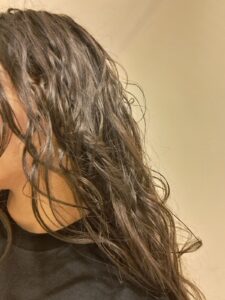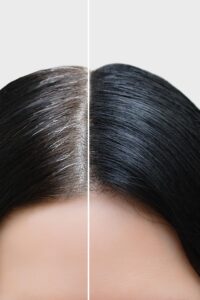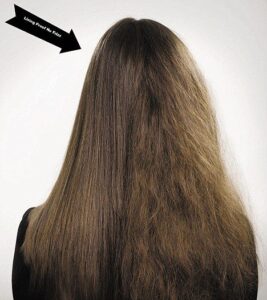Rainy Season Hair Breakage? Here’s What’s Really Going On
1. Introduction: When Rain Feels Good but Hair Doesn’t
- The earthy scent of rain, cool breezes, and verdant surroundings make the monsoon season a pleasant respite from the summer heat. Your hair may convey a different message, even though the rain may feel nice on your skin.
- Monsoon Hair Breakage Many people experience frizz, hair loss, greasy scalps, lifeless hair, and frequent breakage during the rainy season. Why does rain, which is so calming and natural, produce so much trouble for our hair?
- I can state with confidence that the change in weather causes a major alteration in the health of the scalp and hair because I have personally experienced and researched monsoon-related hair issues.

- According to personal experience, many people observe that during the monsoon, their hair falls out more frequently and their scalps become itchy.
- Despite being natural, rainwater frequently contains contaminants that can accumulate, damage hair follicles, and cause fungal infections as it dries on your scalp and hair.
- You have the ideal conditions for dandruff and irritation to flourish when you combine this with the wet scalp conditions brought on by continuous humidity.
- High air humidity causes the hair shaft to swell and the cuticle to lift, giving the appearance of rough, frizzy, and difficult-to-manage hair, according to experts in trichology, the study of hair and scalp. This impact is particularly noticeable for people with wavy or curly hair.
- Climate has a major impact on hair health, according to credible sources like the International Journal of Trichology and several dermatological research.
- A research in the Journal of Clinical and Aesthetic Dermatology found that fungal infections, telogen effluvium (seasonal hair loss), and seborrheic dermatitis (dandruff) all noticeably rise during the monsoon season.
- During the monsoon, it’s critical to rely on factual, scientifically supported hair care regimens when it comes to credibility.
- This entails understanding what to prioritize, such as washing with a mild shampoo, applying lightweight anti-frizz serums, and nourishing the scalp with natural oils or gels, and what to avoid, such as leaving wet hair tied up, skipping hair wash days after being exposed to rain, or using heavy chemical-based styling products.
2. The Science Behind Monsoon Hair Breakage
- How Hair Structure Is Affected by High Humidity | Why Too Much Moisture Causes Weak Strands | How Porosity Makes Hair Vulnerable
- Unquestionably, monsoon hair loss feels unrelenting. There are more hairs on your brush than usual when you comb your hair. However, the science underlying this is well established, so it’s not just a seasonal coincidence.
- A deeper examination of how humidity, moisture overload, and hair porosity combine to weaken hair from the inside out is necessary to comprehend why hair breakage occurs during the monsoon season.
- From a scientific and knowledge-based standpoint, keratin, a protein that forms long chains and provides hair its strength and structure, makes up the majority of hair. Lipids (fats) found in hair also serve as a barrier, shielding it from harm from the environment.

- Additionally, excessive wetness damages hair strands by diluting the proteins and natural oils that coat and shield the hair. Water can remove the lipid layer from hair, particularly if it is acidic or includes contaminants, as rainwater frequently does.
- The hair shaft becomes less elastic, more porous, and more vulnerable to external stressors like brushing, tying, and even towel drying after the protective layer is broken.
- This leads us to the significance of hair porosity, which is frequently disregarded. The ability of hair to absorb and hold onto moisture is known as hair porosity. While high-porosity hair absorbs moisture rapidly but finds it difficult to retain it, low-porosity hair repels water and is more resilient to swelling caused by humidity.
- This is supported by experience and observation; innumerable people have reported that even light style increases breakage during the monsoon season. Hair feels less elastic, frizzier, and more tangled.
- Additionally, you may notice that your hair falls out more when you’re combing or taking a shower. This is frequently misdiagnosed as scalp-related hair loss, although it’s actually an instance of weak hair breaking off.
- During the monsoon season, reputable authorities including as trichologists and dermatologists advise implementing a humidity-resistant regimen. This entails minimizing heat style, which further dehydrates the hair shaft, avoiding harsh shampoos that strip the scalp, and sealing moisture with light oils or hair serums.
- Adhering to product-safe and scientifically sound practices is essential for establishing confidence. Select formulas that are intended to preserve the integrity of the cuticle and increase the amount of protein in the hair.
- Aloe vera, argan oil, panthenol, and hydrolyzed keratin are among the ingredients that work especially well to lessen breakage and moisture overload.
- To sum up, breakage during the monsoon season isn’t just about being wet; it’s also about how your hair responds to an unexpected surge of moisture and whether it has the structural strength to withstand it. And with the correct information and hair care regimen, we can overcome that obstacle.
3. Scalp Issues That Contribute to Hair Breakage
- We frequently concentrate on the hair shaft itself—dryness, frizz, and split ends—when addressing hair breakage during the monsoon. A bit higher up, however, is the scalp, which is one of the most disregarded causes.
- Monsoon Hair Breakage The basis for robust hair is a healthy scalp. Additionally, it turns into a hotspot for a number of problems during the rainy season that subtly damage hair from the root, hastening breakdown.
- The prevalence of fungal infections and scalp accumulation during the monsoon season is startlingly high. A damp atmosphere created by the continuous humidity is perfect for the growth of fungi, particularly Malassezia, a naturally occurring fungus that may proliferate in damp environments.

- This is when experience is useful. Seasonal breakage is frequently accompanied by increased greasiness, flaking, or itching of the scalp. It is not a coincidence link. Hair roots are deprived of oxygen and nutrients when your scalp isn’t breathing correctly, which are both necessary for strong, healthy hair development.
- Sweating beneath helmets, scarves, or wet hair accessories during the rainy season further restricts airflow to the scalp. This creates a crowded scalp environment where breakage is unavoidable when combined with filth, precipitation, and postponed washings.
- Sweat and dirt play an especially damaging influence. Salts and toxins found in sweat can form into crystals that hurt the scalp if they are not wiped off. This sweat and rainfall combine with dirt and pollution particles to create a film that clogs pores.
- According to reputable dermatology research, microbial accumulation and inadequate scalp circulation are two of the main causes of weakening hair structure.
- Gentle exfoliating scalp masks, antifungal shampoos, and calming scalp serums that replenish equilibrium and oxygenation are common monsoon trichological therapies.
- During this period, always choose products free of alcohols, parabens, and sulfates to keep your credibility intact.
- Avoid over-oiling the scalp (which can trap extra dirt), prioritize using light anti-fungal or herbal shampoos, and clean your scalp gently but frequently. Salicylic acid, aloe vera, neem, and tea tree oil are a few substances that can promote a healthier, cleaner scalp without stripping it.
4. The Frizz Factor: Why Hair Loses Smoothness in Rainy Weather
- Although the monsoon season may seem romantic and revitalizing, it usually means battle for your hair, particularly when it comes to frizz. Not only is that unruly, puffed-up, static-prone texture unsightly, but it also indicates more serious structural problems with the hair. The way your hair reacts to moisture in the air and its ability to defend itself are the main factors that determine whether or not you get frizz during the rainy season.
- Let’s talk about experience first. The fear of going out in excessive humidity is familiar to anyone with even the smallest curl or wave in their hair. That meticulously manicured appearance transforms into a frizz halo in a matter of minutes.

- The scientific explanation is as follows: The cuticle, a flat, compact outer layer of healthy hair, functions similarly to roof shingles.
- This layer remains smooth and closed at low humidity levels. However, high humidity causes these cuticles to rise and expand, which lets more water into the hair shaft.
- You guessed it: frizz, misplaced strands, and uneven swelling result from this. Similar to how wood expands unevenly in wet weather, hair does the same.
- Let’s now discuss porosity, which is essential to frizz. The ease with which hair absorbs and holds onto moisture is known as hair porosity. Open, elevated cuticles are a characteristic of high-porosity hair, which is typically damaged by heat, coloring, or sun exposure.
- Dermatologists and hair specialists advise layering and sealing in hydration from an authorized care standpoint.
- This entails closing the cuticle with a light conditioner or leave-in cream after using a moisturizing shampoo.
- A moisture barrier that keeps the hair cuticle smooth and sealed can be produced by using anti-frizz serums or gels that contain substances like aloe vera, argan oil, glycerin, or panthenol.
- It’s critical to acknowledge that not all frizz-fighting solutions are made equal in order to foster confidence. Many “quick-fix” serums contain silicones, which can cause accumulation over time yet offer momentary smoothness.
- Choose nutritious, non-toxic products that hydrate, strengthen, and smoothen your hair from the inside out for long-lasting effects.
5. Dullness During Monsoons: Why Your Hair Loses Shine
- Ironically, rainy days tend to detract from the luster of your hair, even though they may make your complexion look more radiant. You’re not the only one whose hair seems lifeless, flat, and drab during the monsoon. The absence of shine is not merely a cosmetic problem; rather, it is an obvious indication that your hair is not healthy, hydrated, or clean. We must comprehend the underlying causes in order to fix it.
- First, let’s talk about observation and experience. Even newly washed hair appears lifeless and lustrous during the monsoon season, as many people have seen. The texture is harsh or sticky, and there is no natural luster or bounce. This is because the hair cuticle, which is in charge of reflecting light, is attacked by a variety of environmental variables.

- The main offenders are pollution, precipitation, and product accumulation. Rainwater frequently contains elements of dirt, smoke, and industrial contaminants, therefore it is not always pure. Your hair is left with an uneven layer of mineral residue after this water dries.
- A dull, coated surface that is unable to reflect light is the result of frequent usage of styling creams, anti-frizz serums, and sporadic oiling, all of which can accumulate if not thoroughly cleaned out.
- According to experts and scientists, overburdened strands are frequently the cause of dull hair during the monsoon season. Hair turns into a sponge, absorbing product, water, and pollutants, but it is not resilient enough to return to its original state.
- A key reason for dullness is the loss of natural oils. Sebum produced by the scalp helps give hair its natural shine. But frequent wetting and washing — especially with shampoos containing sulfates — strip away this oil layer. Without it, hair looks matte, dry, and tired. It may feel clean, but it lacks the softness and gloss associated with healthy hair.
- The depletion of natural oils is a major cause of dullness. The scalp’s production of sebum contributes to the natural sheen of hair. This oil coating is removed by repeated washing and soaking, particularly with sulfate-containing shampoos. Hair seems dry, matte, and worn out without it. Even while it feels clean, it doesn’t have the lustrous sheen and softness of healthy hair.
- Trichologists advise using a clarifying shampoo once every 1-2 weeks during the monsoon season to get rid of product and pollutant accumulation. Without being overly abrasive, these solutions provide a thorough cleansing. Use a conditioner with shine-boosting components like plant-based keratin, jojoba oil, or argan oil afterward. These restore vital moisture and nutrients while also smoothing the cuticle.
6. How to Prevent Hair Breakage During Monsoon
- If you follow the proper preventative measures, the monsoon season need not be associated with terrible hair days or, worse, hair breakage. Now that you know the science underlying why rain damages your hair, it’s time to do something about it. All you need for these useful adjustments is consistency, the appropriate methods, and wise product selections—not a trip to the salon.
- First, let’s talk about the foundation of monsoon hair care: Use mild, sulfate-free hair cleansers instead. Sulfates, which are frequently present in foaming shampoos, can deplete the natural oils on your scalp. This causes further dryness, brittleness, and breakage in your hair during the monsoon, when it is already having difficulty holding onto its natural moisture content.

- Another important but frequently overlooked step? letting your hair air dry correctly. Many people use fans or air conditioners to dry their damp hair or tie it up. As a result, the roots become weaker and snap more easily.
- Never rub your hair; instead, gently towel-dry it with a microfiber towel. Then, let it air dry, out of the sun and wind. During the monsoon, stay away from using heated appliances like straighteners or blow dryers because the combination of heat and humid air can cause cuticle cracking.
- Finally, use microfiber towels and wide-tooth combs. Because post-shower hair is more elastic and delicate, it might break easily with a cotton towel or thin brush. Without pulling, a wide-tooth comb may remove tangles. Microfiber towels effectively absorb moisture without causing cuticle roughness.
7. Home Remedies & Natural Oils That Help
- You don’t necessarily have to use store-bought remedies to repair hair loss caused by the monsoon. For internal hair restoration and protection, nature offers some of the safest, most economical, and most efficient solutions.
- These natural solutions, which have their roots in traditional knowledge and are becoming more scientifically supported, can help strengthen hair, restore moisture balance, and fight damage caused by humidity.
- This monsoon, let’s discuss how to maintain the health of your hair with natural oils, gels, masks, and herbal rinses.
- Aloe Vera, Coconut Oil, and Hibiscus Gel: Nature’s Triple Threat for Stronger Hair
- For good reason, coconut oil is still among the most suggested natural oils. According to research and conventional Ayurvedic methods, coconut oil has a special capacity to enter the hair shaft and prevent protein loss.
- Made from crushed hibiscus flowers or premade compositions, hibiscus gel is high in antioxidants, flavonoids, and amino acids. It is mild and non-greasy while strengthening hair roots, reducing frizz, and adding natural shine. Use it as a leave-in conditioner after washing, or combine it with aloe vera gel to make a hair mask that prevents damage.
- Speaking of aloe vera, it’s perfect for monsoon hair care because of its antibacterial and hydrating qualities. Aloe helps heal fungal infections, hold in moisture without making your hair limp, and calm irritated scalps. You may use it directly from the plant or as a store-bought pure gel. All hair types can safely use it, and it’s lightweight and cooling.
FAQS
1. Why does my hair fall more during the monsoon season?
Humidity and frequent exposure to rainwater can disrupt the scalp’s microbiome, increase fungal infections, and weaken hair roots. Sweat, dirt, and buildup also clog follicles, reducing oxygen supply. These conditions collectively lead to increased hair fall and breakage.
2. Does rainwater actually damage hair?
Yes, especially if the rainwater is acidic or polluted. Rainwater in urban areas often contains impurities like dust, heavy metals, and toxins that cling to the hair shaft, causing dullness, frizz, and scalp irritation. Rinsing with clean water after rain exposure is crucial.
3. Should I oil my hair during monsoon?
Yes, but in moderation. Lightweight oils like coconut, jojoba, or rosemary oil can help nourish hair and protect it from humidity. Avoid heavy oiling or leaving oil overnight, as it may trap dirt and moisture, leading to fungal growth.
4. How often should I wash my hair during monsoon?
2 to 3 times a week is ideal. If your scalp gets wet in the rain or sweats heavily, wash it sooner with a mild, sulfate-free shampoo. The goal is to maintain a clean, breathable scalp without over-drying it.
5. What is the best shampoo for monsoon hair care?
Use a sulfate-free, gentle shampoo with anti-fungal or balancing ingredients like tea tree, neem, aloe vera, or green tea extract. Clarifying shampoos can be used once a week to remove buildup.
6. How can I reduce frizz naturally during monsoon?
Use leave-in conditioners or natural anti-frizz gels like aloe vera or hibiscus gel. Avoid heat styling, use a microfiber towel, and seal the cuticle with a light oil or serum. Deep condition weekly to keep strands smooth and hydrated.
7. Can fungal scalp infections cause breakage?
Absolutely. Fungal infections lead to inflammation, itching, and scaling — which damage the hair follicles. This results in weak, brittle strands that break easily. Treat fungal issues with anti-fungal shampoos and scalp detox remedies like neem or apple cider vinegar.
8. Is it okay to tie wet hair during the monsoon?
No. Tying wet hair traps moisture and creates the perfect environment for bacterial and fungal growth on the scalp. It also weakens the hair shaft, increasing the risk of breakage. Always let your hair dry fully before tying it.
9. What are the best DIY treatments for monsoon hair breakage?
DIY masks with ingredients like banana + honey, fenugreek paste, or amla + aloe vera deeply hydrate and strengthen hair. Herbal rinses with neem or rosemary can detox the scalp and boost root health.
10. How long does it take to see improvement with monsoon hair care routines?
With consistent care — including a proper wash routine, hydration, and scalp detox — most people begin to see improvements in 2 to 4 weeks. Results vary based on hair type and scalp condition, but patience and regularity are key.
